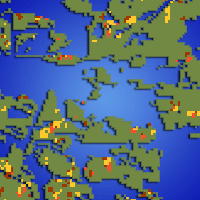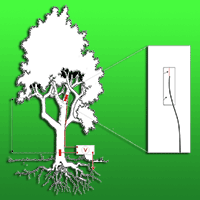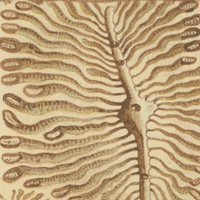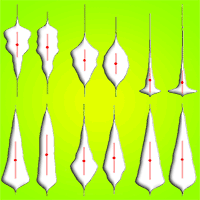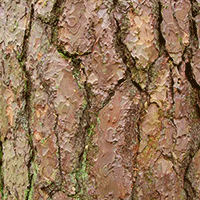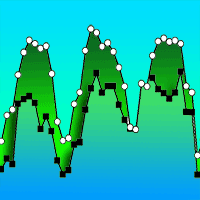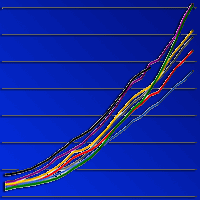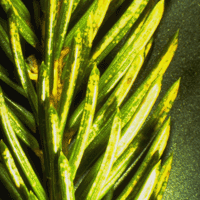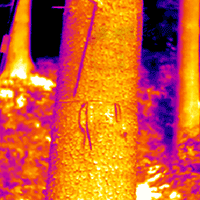
Determination of differences in temperature regimes on healthy and bark-beetle colonised spruce trees using a handheld thermal camera
Andrej Majdák (1) , Rastislav Jakuš (1-2), Miroslav Blaženec (1)
iForest - Biogeosciences and Forestry, Volume 14, Issue 3, Pages 203-211 (2021)
doi: https://doi.org/10.3832/ifor3531-014
Published: May 02, 2021 - Copyright © 2021 SISEF
Research Articles
Abstract
In this study, we compared the daily temperature regimes of healthy uninfected trees in the interior of a forest stand and at the fresh forest edge with infested trees at the forest edge in an area affected by a bark beetle outbreak. We estimated the potential of a handheld thermal camera for early identification of bark-beetle infested trees. We show that infested trees have significantly higher trunk temperatures than uninfested trees, which is more visible on the shine side of the trunk, and we report the differences in temperature between the shine and shadow sides. The differences are more noticeable on a warm, bright, and sunny day than on cold and cloudy day. The different intensity of solar radiation does not affect the distinction between infested and uninfested trees. The handheld thermal camera shows potential for identifying bark-beetle infested trees by scanning tree trunks on bright sunny days.
Keywords
Bark-beetle Infested Trees, Handheld Thermal Camera, Incoming Solar Radiation, Norway Spruce, Solar Radiation Modelling, Temperature Differences
Authors’ Info
Authors’ address
Rastislav Jakuš 0000-0003-2280-1952
Miroslav Blaženec 0000-0001-9743-614X
Institute of Forest Ecology, Slovak Academy of Sciences, Ludovíta Štúra 2, 960 53 Zvolen (Slovak Republic)
Faculty of Forestry and Wood Sciences, Czech University of Life Sciences, Kamýcká 1176, 165 21 Praha 6 - Suchdol (Czech Republic)
Corresponding author
Paper Info
Citation
Majdák A, Jakuš R, Blaženec M (2021). Determination of differences in temperature regimes on healthy and bark-beetle colonised spruce trees using a handheld thermal camera. iForest 14: 203-211. - doi: 10.3832/ifor3531-014
Academic Editor
Carlotta Ferrara
Paper history
Received: May 21, 2020
Accepted: Feb 23, 2021
First online: May 02, 2021
Publication Date: Jun 30, 2021
Publication Time: 2.27 months
Copyright Information
© SISEF - The Italian Society of Silviculture and Forest Ecology 2021
Open Access
This article is distributed under the terms of the Creative Commons Attribution-Non Commercial 4.0 International (https://creativecommons.org/licenses/by-nc/4.0/), which permits unrestricted use, distribution, and reproduction in any medium, provided you give appropriate credit to the original author(s) and the source, provide a link to the Creative Commons license, and indicate if changes were made.
Web Metrics
Breakdown by View Type
Article Usage
Total Article Views: 35235
(from publication date up to now)
Breakdown by View Type
HTML Page Views: 29520
Abstract Page Views: 2701
PDF Downloads: 2436
Citation/Reference Downloads: 5
XML Downloads: 573
Web Metrics
Days since publication: 1689
Overall contacts: 35235
Avg. contacts per week: 146.03
Citation Metrics
Article Citations
Article citations are based on data periodically collected from the Clarivate Web of Science web site
(last update: Mar 2025)
Total number of cites (since 2021): 12
Average cites per year: 2.40
Publication Metrics
by Dimensions ©
Articles citing this article
List of the papers citing this article based on CrossRef Cited-by.
References
Influence of temperature upon the development and voltinism of Ips typographus L. (Coleoptera, Scolytidae). Annales Zoologici Fennici 6: 161-208.
Gscholar
Gehalt und Emission von Monoterpenen der Fichtenrinde und deren Bedeutung für die Primärattraktion von Borkenkäfern (Coleoptera, Scolytidae). [Monoterpene content and monoterpene emission of Norway spruce bark and their relation to the primary attraction of bark beetles (Coleoptera, Scolytidae)]. Mitteilungen Der Deutschen Gesellschaft für Allgemeine fnd Angewandte Entomologie 11: 639-643. [in German]
Gscholar
Detection of red palm weevil infected trees using thermal imaging. In: Proceedings of the “10th European Conference on Precision Agriculture, ECPA 2015”. Wageningen Academic Publishers, Wageningen, Netherlands, pp. 643-650.
CrossRef | Gscholar
World reference base for soil resources 2014. World Soil Resources Reports no. 106, FAO, Rome, Italy, pp. 192.
Gscholar
Effect of forest structure and health on the relative surface temperature captured by airborne thermal imagery - Case study in Norway Spruce-dominated stands in Southern Finland. Scandinavian Journal of Forest Research 32: 154-165.
CrossRef | Gscholar
Climatic regions 1:1.000.000. In: “Landscape Atlas of the Slovak Republic” (Hrnčiarová T ed). Ministry of Environment of the Slovak Republic, Bratislava, and Slovak Environment Agency, Banská Bystrica, Slovak Republic, pp. 344.
Gscholar
Storms, temperature maxima and the Eurasian spruce bark beetle Ips typographus. An infernal trio in Norway spruce forests of the Central European High Tatra Mountains. Agricultural and Forest Meteorology 242: 85-95.
CrossRef | Gscholar
Remote sensing of bark beetle damage in urban forests at individual tree level using a novel hyperspectral camera from UAV and aircraft. Urban Forestry and Urban Greening 30: 72-83.
CrossRef | Gscholar
UAV-Borne thermal imaging for forest health monitoring: Detection Of disease-induced canopy temperature increase. International Archives of the Photogrammetry, Remote Sensing and Spatial Information Sciences - ISPRS Archives 40: 349-354.
CrossRef | Gscholar
Biologie a ekologie lýkožrouta smrkového (Ips typographus) a ochrana proti nemu [Biology and ecology of the spruce bark beetle (Ips typographus) and its control]. ACADEMIA, nakladatelství CSAV, Praha, Czech Republic, pp. 124.
Gscholar

